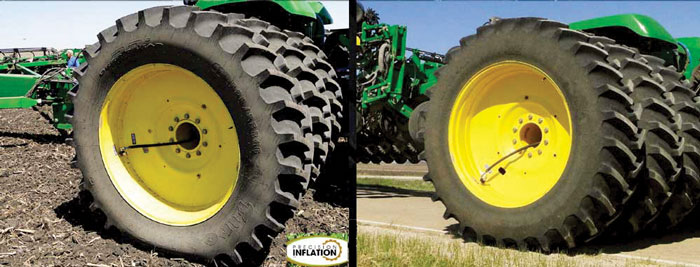Some amount of compaction is inevitable, even for strip-tillers, but there are ways to minimize it by using new technologies developed by the ag tire industry over the past decade.
“If you came to me and said, ‘Minimize compaction on my farm as much as you can,’ I would tell you to go with a VF tire and install a central tire inflation system. That’s the best way,” says James Crouch, national segment manager for Yokohama Off-Highway Tires and self-proclaimed “tire nerd.”
Growers can start by aiming for the biggest, most uniform tire footprint possible, Crouch says. But that doesn’t necessarily mean the biggest tires, especially for strip-tillers looking to steer clear of certain areas in the field.
“The more uniform the footprint, the lower the compaction because it’s all based on weight divided by square inches,” Crouch says. “But sometimes, depending on your fields, you’re locked into a specific tire size.”
Standard radial tires are better at minimizing compaction than old school bias tires, Crouch says, because they create a more uniform footprint. The weight put on bias tires doesn’t spread evenly across the footprint as much as it does with radial tires.
“When you apply weight to radial tires, the sidewall flexes, the tire gets a little bit shorter, and the footprint gets longer,” Crouch says. “With that longer footprint, there’s more rubber on the ground and it’s spreading weight over a larger area. But today we know that increased flexion is an even better option than standard radial.”
IF vs. VF
Strip-tillers should strongly consider using increased flexion (IF) and/or very high flexion (VF) rated tires to alleviate compaction, Crouch says. IF and VF tires are constructed with sidewalls that enable them to bear heavier loads and operate at lower inflation pressures than traditional radial tires.
“VF is the best thing out there right now,” Crouch says. “I’m responsible for requesting and launching new products in the North American market for our company, and I don’t even ask for IF anymore. I only ask for VF because it’s the best solution.”
“I encourage farmers to do the math on central tire inflation systems and calculate the ROI…”
IF tires can carry 20% more weight at the same pressure as a standard radial tire or run at 20% lower pressure and carry the same load as a radial tire, whereas VF tires double both of those numbers. For example, if tire pressure is 20 pounds per square inch (PSI) with a standard radial tire, an IF tire could carry the same weight at 16 PSI and a VF tire at 12 PSI.
“Flexion technology gives you a nice little bulge on the bottom of the tire that we like to see,” Crouch says. “A lot of people think that means the tire is flat, but it’s not. The sidewalls are designed to flex more, and the shoulders are lighter. There are several different schools of thought on how big of an impact lower tire pressure has on compaction. It could be vastly different for strip-tillers in different regions, depending on their soil types. But I know for certain that lower tire pressure means less compaction.”
What’s Next?
Crouch, who’s worked in the ag tire industry for almost 25 years, says VF technology is the biggest breakthrough since radial tires.
“But what’s next?” Crouch asks. “We’re not just twiddling our thumbs, waiting on VF to take over the world. There has to be something else to help farmers reduce compaction and increase their yield.”
The central tire inflation system (CTIS) is the next big thing on the horizon, Crouch believes. A CTIS is an aftermarket solution that ensures tires run at the exact correct pressure all the time, whether it’s a standard radial, IF or VF.

ADJUSTING ON THE FLY. A central tire inflation system (CTIS) can make quick work of changing the air pressure of a tire, whether it’s decompressing down to 7 psi for the field (L) or inflating to 20 psi for the road (R). Photo by: Precision Inflation
“Once the CTIS is installed, there’s a little box in the cab that has field and road options,” Crouch says. “When you get to the field and start to fold your implement out, the weight comes off the draw bar. Now you’re overinflated, which is bad for compaction because your footprint is smaller. The CTIS gives you a way to counteract that. You hit the field button, and it drops your air pressure down to your field speed and field load, instead of having your tire pressure set for 30 mph when you were in transport mode.”
Original equipment manufacturers (OEMs) in Europe are already integrating CTIS into some of their machines, and it’s only a matter of time until OEMs in North America follow suit, Crouch says. He believes 5-10 years from now, CTIS will be as commonly used as VF technology.
Barriers to Adoption
Money is the biggest barrier preventing more strip-tillers from using VF and CTIS technology, Crouch says.
“VF tires are more expensive than standard radial tires,” he says. “Radial is more expensive than bias, and so on. A CTIS can range from $20,000-$30,000. It’s not cheap, but just like anything else, I encourage farmers to do the math and calculate the ROI.”
Crouch says recent studies concluded VF technology could increase yield by 7%.
“That’s huge. Let’s say the study is wrong, and the yield increase is only half of that. Even a 3.5% bump in yield is huge. You’d be paying off that CTIS pretty quickly.”
Tread Pattern Matters
Certain tread patterns can help alleviate compaction, James Crouch says, largely because of the pattern’s ability to reduce slip in the field.
“Slip does increase compaction because as you’re turning that tire around, you’re putting a lot of pressure on the soil,” Crouch says. “Look for tread patterns that create a happy medium between forward and lateral traction. For example, on our combine tires we offer a 45-degree tread bar, which we think is optimal for lateral and forward traction.”
Advanced tread patterns can also enhance sprayer accuracy as well.
“Minimizing slip and maximizing your controllability in the field will lead to more precise applications and a better ROI,” Crouch says.
The 363 tread pattern is the best option for sprayers that spend as much time on the road as the field, Crouch says. The 363 pattern combines a traditional curved lug with blocks to produce more biting edges for enhanced traction in the field, and its large number of blocks and high rubber-to-void tread ratio deliver long wear on the road.
Crouch encourages strip-tillers to learn more about advanced tread patterns by contacting their local tire expert.
The aesthetics of a CTIS might also make some farmers hesitant, says Crouch, who admits some of the aftermarket solutions aren’t very easy on the eyes.
“The CTIS adds a lot of mechanisms to the machine,” Crouch says. “They might have lines hanging out over the tires, and they’re a little more complicated to get established on a dual setup than a single.”
Overinflation Nation
Strip-tillers who don’t have the budget for IF, VF or CTIS can still manage compaction by performing routine maintenance checks on their tires. The offseason is the perfect time to make sure there aren’t any cracks, leaks or objects lodged in the tires.
“It’s not uncommon to see bolts, deer antlers or stubble lodged in tires,” Crouch says. “Also, check your tire pressure before you get busy. You don’t want to wait until spring when you’re prepping your planter, only to discover you need a new tire, but your tire guy can’t get it to you in time. That’s a nightmare scenario.”
“About 75% of tires on tractors are overinflated…”
Many strip-tillers make the mistake of overinflating their tires because they see a bulge or deformity in the bottom. Crouch recommends contacting your local dealer to get connected with an ag tire expert who can help set your tire pressure to the correct number.
“About 75% of tires on tractors are overinflated,” Crouch says. “That bulge is supposed to be there on the bottom of the tire. Give us a chance to help set your air pressure. A machine with properly inflated tires will ride better, reduce compaction and slip, and increase your fuel efficiency and yield.”







